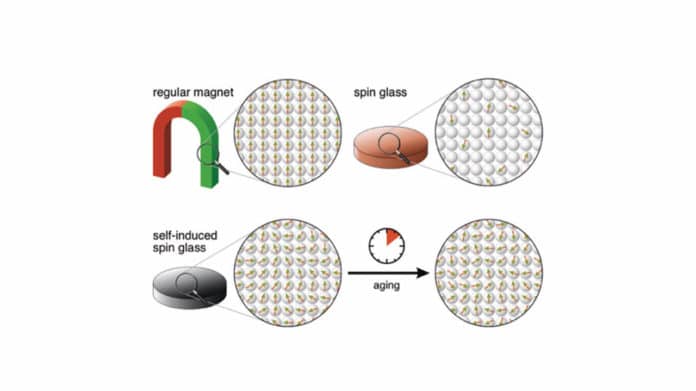In a recent study, scientists found that the material neodymium behaves in a complex magnetic way that has not been observed before in any element on the periodic table.
A new study has suggested that the chemical element Neodymium (Nd) acts as self-induced spin glass. They found that element is composed of a rippled sea of many tiny whirling magnets circulating at different speeds and constantly evolving.
According to scientists, shedding light on such magnetic behavior could help them understand elements on the periodic table and eventually could pave the way for new materials for artificial intelligence.
Spin glasses that form in disordered materials such as magnetic alloys have locally varying magnetic patterns, and their spin relaxation occurs over time scales spanning many orders of magnitude.
Using spin-polarized scanning tunneling microscopy, scientists imaged the magnetism on the (0001) surface of thick, single-crystal films of neodymium as a function of temperature and magnetic field. Despite the lack of structural disorder, they found a spectral distribution of degenerate magnetic wave vectors, that exhibited spatiotemporal variation.
Assistant professor Daniel Wegner found that the material neodymium behaves in a complex magnetic way that no one ever saw before in an element on the periodic table said, “In Nijmegen, we are specialists in scanning tunneling microscopy (STM). It allows us to see the structure of individual atoms, and we can resolve the north and south poles of the atoms. With this advancement in high-precision imaging, we were able to discover the behavior in neodymium, because we could resolve the incredibly small changes in the magnetic structure. That’s not an easy thing to do.”
Alexander Khajetoorians, a professor in Scanning probe microscopy, said, “This finding opens up the possibility that this complex and glassy magnetic behavior could also be observed in uncountable new materials, including other elements on the periodic table. It will refine textbook knowledge of the basic properties of matter. But it will also provide a proving ground to develop new theories where we can link physics to other fields, for example, theoretical neuroscience.”
“The complex evolution of neodymium may be a platform to mimic basic behavior used in artificial intelligence. All the complex patterns which can be stored in this material can be linked to image recognition.”
With the advancement of AI and its large energy footprint, there is an increasing demand to create materials that can perform brain-like tasks directly in hardware. You could never build a brain-inspired computer with simple magnets, but materials with this complex behavior could be suitable candidates.”
The study has been conducted by physicists at Radboud University and Uppsala University.
Journal Reference:
- Umut Kamber et al., Self-induced spin-glass state in elemental and crystalline neodymium. DOI: 10.1126/science.aay6757
